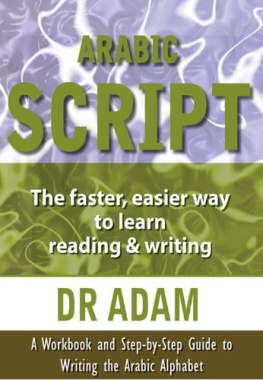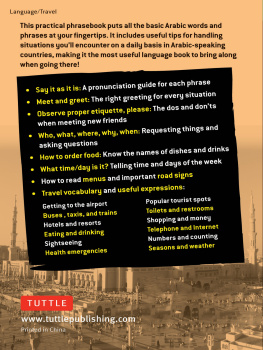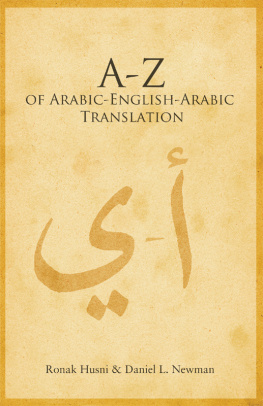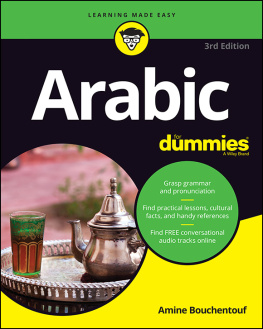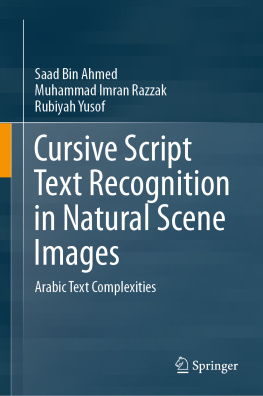Dr. Adam - Arabic Script
Here you can read online Dr. Adam - Arabic Script full text of the book (entire story) in english for free. Download pdf and epub, get meaning, cover and reviews about this ebook. year: 2011, publisher: CreateSpace, genre: Children. Description of the work, (preface) as well as reviews are available. Best literature library LitArk.com created for fans of good reading and offers a wide selection of genres:
Romance novel
Science fiction
Adventure
Detective
Science
History
Home and family
Prose
Art
Politics
Computer
Non-fiction
Religion
Business
Children
Humor
Choose a favorite category and find really read worthwhile books. Enjoy immersion in the world of imagination, feel the emotions of the characters or learn something new for yourself, make an fascinating discovery.
Arabic Script: summary, description and annotation
We offer to read an annotation, description, summary or preface (depends on what the author of the book "Arabic Script" wrote himself). If you haven't found the necessary information about the book — write in the comments, we will try to find it.
Arabic Script — read online for free the complete book (whole text) full work
Below is the text of the book, divided by pages. System saving the place of the last page read, allows you to conveniently read the book "Arabic Script" online for free, without having to search again every time where you left off. Put a bookmark, and you can go to the page where you finished reading at any time.
Font size:
Interval:
Bookmark:
 http://www.LetsTalkArabic.com This title is also available at major online book retailers.
http://www.LetsTalkArabic.com This title is also available at major online book retailers.
For whatever reason it may be, a new challenge, relocation to an Arabic speaking country or for business, you can rest assured that you have made another great decision in choosing one of the most successful and smoothest Arabic courses. This book will lead you to push yourself and take a step above the rest in a fun and interactive way. Arabic is considered to be one of the most alive, important and beautiful languages in the world. This book uses an extremely stimulating, logical and easy way to help you learn from the very beginning. In any language, speaking appears to be the most fundamental aspect for a lot of people. From the start of the book, you will be introduced to the basics of speaking and pronunciation, using a simple format that allows everyone to speak Arabic in a natural way.
The book will then continue to develop your new skills by enabling you to understand and heighten your ability to read, listen to and write this amazing language. Arabic is a Semitic language and is the formal and official language of 22 Arab countries. It is also the spoken language of almost 420 million people living in Arabic and non Arabic countries. This book will teach you the basics of Modern Standard Arabic (MSA), which is the modernization of the Classical Arabic structures, as well as additions from the main dialects spoken all over the Arab world. Variations of the Language Like any other language, spoken Arabic has some dialects with variations and differences. The differences between these dialects are incomprehensible from one to the other, and can be referred to as five main dialects divided according to their regions.
Maghreb The Maghreb dialect is spoken in the region of the Maghreb countries, Libya, Tunisia, Algeria, Mauritania, and Morocco. Egyptian: The Egyptian dialect is used in Egypt, Sudan, Yemen, and some western parts of Saudi Arabia. It is the most widely understood colloquial dialect across the Arab world, because almost 93% of Arabic Movies, TV, and Media use the Egyptian dialect. Levantine The Levantine dialect comes from and is used in Lebanon, Palestine, Jordan and Syria. The Gulf The Gulf dialect is spoken in the Arabic Gulf Countries, which are made up by Iraq, Kuwait, most of Saudi Arabia, Qatar, Bahrain, the United Arab Emirates, and Oman.  The dark countries on the map show the Arab League.
The dark countries on the map show the Arab League.  The dark countries on the map show the Arab League.
The dark countries on the map show the Arab League.
Written Arabic The core of Arabic writing that is used today comes from the classical Arabic which is principally defined as the Arabic used in the Qur'an and in the earliest form of literature from the Arabian Peninsula. Two Important Facts The First is that, any language has a vast wealth of vocabulary, but do we need to learn that vast amount to be able to communicate in a language? Of course not! Just, 20% of the words in a language make up to 80% of the conversations we face in our daily life. You may not be speaking like a native immediately, but you'll have a solid base and the ability to keep improving and developing yourself. This method is suitable for everyone from frequent travelers to first timers, as well as language students and enthusiasts. So, this book focuses on the vital 20% that will help you speak Arabic interactively and dynamically. The second point and this is a really exciting fact.
The Arabic language uses word roots, for example, we can take one root like ( KTB ) from the word ( K a T a B a) which means "he wrote" and from there conjugate all Arabic verbs tense. Nouns can also be made from the same root because they have a relation with it.  Arabic grammar is fairly simple compared to Western languages, but the language itself has richness in its vocabulary that exceeds most languages in the Western world.
Arabic grammar is fairly simple compared to Western languages, but the language itself has richness in its vocabulary that exceeds most languages in the Western world.
The following Arabic letters do not have any correspondence in the Latin alphabet. For example: kh (equals German ch), gh (a softer version of kh). cayn (guttural stop, but clearly pronounced from the back of the throat), th (as in English). dh (softer version of th), sh (as in English) and strong and emphasized versions of the letters t, d, s, z, h. One letter, called hamza, is not even pronounced, other than as a glottal stop. In transcriptions it is marked with a ' only.
Below is the Arabic alphabet and key to show you how to pronounce them. Try to read paying attention to the pronunciation. 

 ); this slash known as Fat-Ha . - If the slash is below (
); this slash known as Fat-Ha . - If the slash is below (  ); this is known as Kasra . - If a mark which looks like an apostrophe is used (
); this is known as Kasra . - If a mark which looks like an apostrophe is used (  ); we call this Damma , meaning it is pronounced with that short vowel mark.
); we call this Damma , meaning it is pronounced with that short vowel mark.Font size:
Interval:
Bookmark:
Similar books «Arabic Script»
Look at similar books to Arabic Script. We have selected literature similar in name and meaning in the hope of providing readers with more options to find new, interesting, not yet read works.
Discussion, reviews of the book Arabic Script and just readers' own opinions. Leave your comments, write what you think about the work, its meaning or the main characters. Specify what exactly you liked and what you didn't like, and why you think so.

